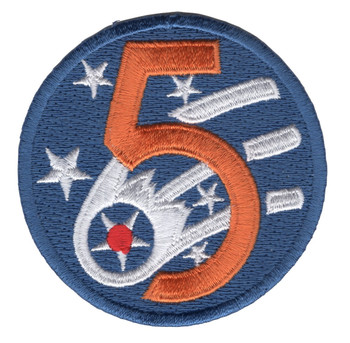Description
8th Air Force Shoulder Patch (U.S. Air Force) 2.5" x 2.5" Embroidered Patch with Iron-On Backing
Superior Materials: Made with premium polyester thread and durable twill fabric, ensuring long-lasting color and strength.
Advanced Embroidery Technology: Crafted using the most advanced embroidery machinery, guaranteeing intricate detail, sharp lines, and consistent quality every time.
Easy Iron-On Application: Features a heat-activated adhesive backing for quick, no-sew attachment. Simply position, iron, and press for a secure bond.
Versatile Use: Perfect for personalizing jackets, backpacks, uniforms, or any fabric surface that needs a touch of personality.
Durable and Washable: Designed to withstand everyday wear and occasional washing without fading or fraying.
Formations & Origins
The 8th Air Force was born in the crucible of World War II, formally established on January 28, 1942, just weeks after Pearl Harbor. Its mission: bring the war to Hitler’s doorstep by dominating the skies over Europe. From humble beginnings, it grew into a juggernaut — the backbone of America’s strategic bombing campaign against Nazi Germany. Stationed in England, it quickly became the largest of all numbered air forces under the U.S. Army Air Forces, fielding tens of thousands of aircrew and support personnel. It was nicknamed "The Mighty Eighth" — and rightly so. Its formation marked the beginning of America’s shift toward air power as a decisive force in modern warfare.
Notable Commanders
Among the most legendary was General Ira C. Eaker, one of the founding fathers of the Eighth, who helped shape its doctrine of daylight precision bombing. Later came Lt. Gen. Jimmy Doolittle, the same man who led the Doolittle Raid on Tokyo in 1942. Under his command, the 8th transitioned from tight, defensive bomber boxes to aggressive fighter-escorted raids deep into enemy territory. Doolittle gave fighter pilots more freedom to chase down Luftwaffe aircraft, and that move arguably helped break the back of the German air force. Another name worth mentioning is Brigadier General Frederick Castle, who was posthumously awarded the Medal of Honor for sacrificing his life to save his crew during a 1944 bombing raid.
Major Campaigns/Operations
The Mighty Eighth’s war record is almost too vast to summarize, but some missions stand above the rest. Its first combat mission was flown on July 4, 1942 — fitting for a force that would come to symbolize American might. The Schweinfurt–Regensburg raids of 1943 aimed to cripple German ball bearing production but came at enormous cost. The Eighth also played a central role in Operation Argument, better known as "Big Week" (February 1944), a sustained bombing assault to draw the Luftwaffe into battle and destroy its fighter force before D-Day. By D-Day itself, June 6, 1944, the Eighth Air Force was bombing coastal defenses, troop formations, and transport hubs. It also had a hand in the bombing campaigns that devastated key cities like Berlin, Hamburg, and Dresden, always with the goal of shattering the Nazi war machine from above.
Specialized Role/Equipment
The 8th Air Force was all about heavy bombers and long-range fighters. The mainstays were the Boeing B-17 Flying Fortress and the Consolidated B-24 Liberator — four-engine monsters bristling with machine guns and packed with payloads of high explosives. The B-17 became an icon of the air war, known for bringing crews home despite horrific damage. Later in the war, the arrival of the P-51 Mustang changed everything. With the range to escort bombers all the way to Berlin and back, these sleek, agile fighters cleared the skies of enemy interceptors. Precision bombing was their doctrine — using the Norden bombsight, crews aimed to hit factories, rail yards, and refineries, though the reality of weather, flak, and enemy fighters often turned missions into chaos.
Acts of Heroism
Heroism was practically standard issue in the Eighth. Thousands of airmen flew missions knowing full well the odds of returning were low — especially during the early unescorted raids. Casualty rates reached as high as 70% for bomber crews in 1943. Entire formations were blown from the sky by flak and Messerschmitts. Stories of valor are countless: bomber pilots who stayed at the controls to keep the aircraft level while their crews bailed out; gunners who fought on through smoke and blood to protect the formation; navigators who guided crippled planes home over the channel with shot-out instruments. More than 17 Medals of Honor were awarded to members of the Eighth Air Force. Perhaps none more poignant than 2nd Lt. Robert Femoyer, a navigator who, after being severely wounded by flak, refused morphine so he could stay conscious and guide his crew back to England — he died shortly after landing.
Legacy & Notable Achievements
The 8th Air Force dropped over 697,000 tons of bombs during WWII and destroyed an estimated 76,000 enemy aircraft. It suffered more than 26,000 combat deaths — more than the entire U.S. Marine Corps in the war. After WWII, the Eighth was reborn under the newly established U.S. Air Force in 1947 as part of Strategic Air Command. During the Cold War, it stood on the nuclear front line, managing fleets of B-52 bombers and ICBMs. Today, it’s headquartered at Barksdale Air Force Base, Louisiana, and commands the nation's long-range strategic bomber force — including the B-1B Lancer, B-2 Spirit, and the B-52 Stratofortress. That same shoulder patch, the white star and red circle flanked by golden wings on a blue field with a figure-eight — is still worn by aircrews who stand ready to strike anywhere in the world. The Mighty Eighth’s legacy isn’t just history — it’s alive in every bomber that lifts off under its banner.







